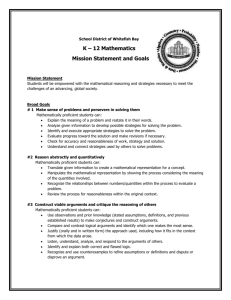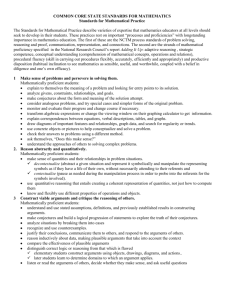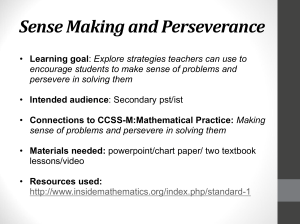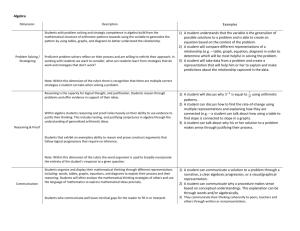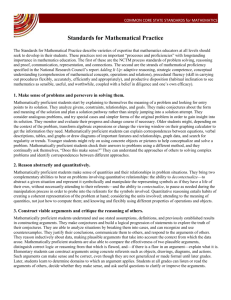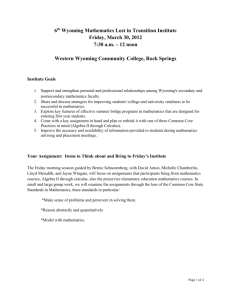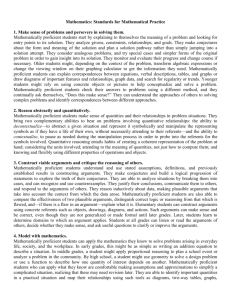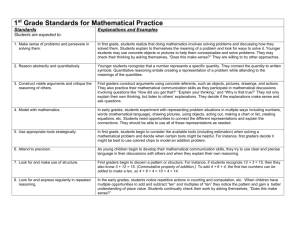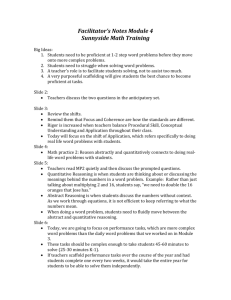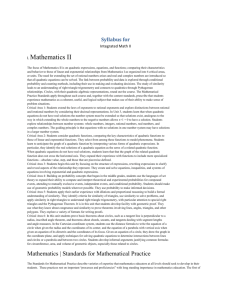Mathematical Practice
advertisement
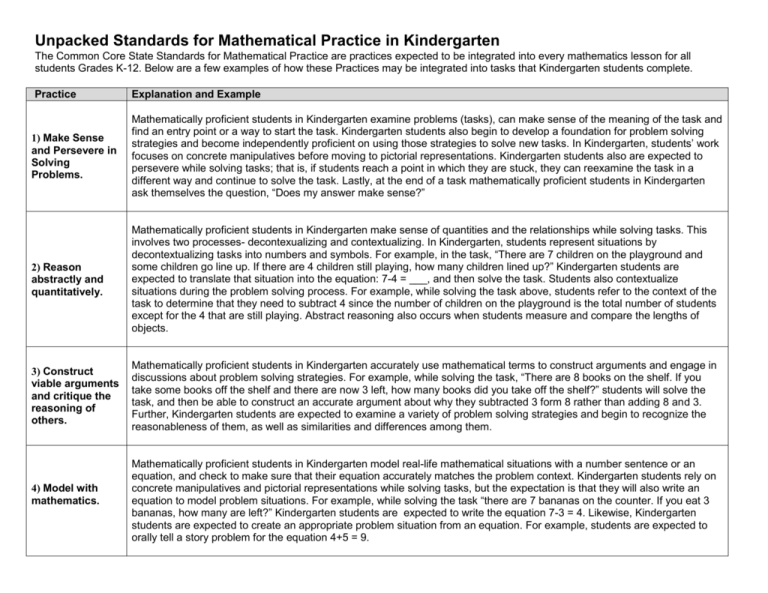
Unpacked Standards for Mathematical Practice in Kindergarten The Common Core State Standards for Mathematical Practice are practices expected to be integrated into every mathematics lesson for all students Grades K-12. Below are a few examples of how these Practices may be integrated into tasks that Kindergarten students complete. Practice Explanation and Example 1) Make Sense and Persevere in Solving Problems. Mathematically proficient students in Kindergarten examine problems (tasks), can make sense of the meaning of the task and find an entry point or a way to start the task. Kindergarten students also begin to develop a foundation for problem solving strategies and become independently proficient on using those strategies to solve new tasks. In Kindergarten, students’ work focuses on concrete manipulatives before moving to pictorial representations. Kindergarten students also are expected to persevere while solving tasks; that is, if students reach a point in which they are stuck, they can reexamine the task in a different way and continue to solve the task. Lastly, at the end of a task mathematically proficient students in Kindergarten ask themselves the question, “Does my answer make sense?” 2) Reason abstractly and quantitatively. Mathematically proficient students in Kindergarten make sense of quantities and the relationships while solving tasks. This involves two processes- decontexualizing and contextualizing. In Kindergarten, students represent situations by decontextualizing tasks into numbers and symbols. For example, in the task, “There are 7 children on the playground and some children go line up. If there are 4 children still playing, how many children lined up?” Kindergarten students are expected to translate that situation into the equation: 7-4 = ___, and then solve the task. Students also contextualize situations during the problem solving process. For example, while solving the task above, students refer to the context of the task to determine that they need to subtract 4 since the number of children on the playground is the total number of students except for the 4 that are still playing. Abstract reasoning also occurs when students measure and compare the lengths of objects. 3) Construct viable arguments and critique the reasoning of others. Mathematically proficient students in Kindergarten accurately use mathematical terms to construct arguments and engage in discussions about problem solving strategies. For example, while solving the task, “There are 8 books on the shelf. If you take some books off the shelf and there are now 3 left, how many books did you take off the shelf?” students will solve the task, and then be able to construct an accurate argument about why they subtracted 3 form 8 rather than adding 8 and 3. Further, Kindergarten students are expected to examine a variety of problem solving strategies and begin to recognize the reasonableness of them, as well as similarities and differences among them. 4) Model with mathematics. Mathematically proficient students in Kindergarten model real-life mathematical situations with a number sentence or an equation, and check to make sure that their equation accurately matches the problem context. Kindergarten students rely on concrete manipulatives and pictorial representations while solving tasks, but the expectation is that they will also write an equation to model problem situations. For example, while solving the task “there are 7 bananas on the counter. If you eat 3 bananas, how many are left?” Kindergarten students are expected to write the equation 7-3 = 4. Likewise, Kindergarten students are expected to create an appropriate problem situation from an equation. For example, students are expected to orally tell a story problem for the equation 4+5 = 9. Standards for Mathematical Practice in Kindergarten – page 2 Practice Explanation and Example 5) Use appropriate tools strategically. Mathematically proficient students in Kindergarten have access to and use tools appropriately. These tools may include counters, place value (base ten) blocks, hundreds number boards, number lines, and concrete geometric shapes (e.g., pattern blocks, 3-d solids). Students should also have experiences with educational technologies, such as calculators, virtual manipulatives, and mathematical games that support conceptual understanding. During classroom instruction, students should have access to various mathematical tools as well as paper, and determine which tools are the most appropriate to use. For example, while solving the task “There are 4 dogs in the park. If 3 more dogs show up, how many dogs are they?” Kindergarten students are expected to explain why they used specific mathematical tools.” 6) Attend to precision Mathematically proficient students in Kindergarten are precise in their communication, calculations, and measurements. In all mathematical tasks, students in Kindergarten describe their actions and strategies clearly, using grade-level appropriate vocabulary accurately as well as giving precise explanations and reasoning regarding their process of finding solutions. For example, while measuring objects iteratively (repetitively), students check to make sure that there are no gaps or overlaps. During tasks involving number sense, students check their work to ensure the accuracy and reasonableness of solutions. 7) Look for and make use of structure Mathematically proficient students in Kindergarten carefully look for patterns and structures in the number system and other areas of mathematics. While solving addition problems, students begin to recognize the commutative property, in that 1+4 = 5, and 4+1 = 5. While decomposing teen numbers, students realize that every number between 11 and 19, can be decomposed into 10 and some leftovers, such as 12 = 10+2, 13 = 10+3, etc. Further, Kindergarten students make use of structures of mathematical tasks when they begin to work with subtraction as missing addend problems, such as 5- 1 = __ can be written as 1+ __ = 5 and can be thought of as how much more do I need to add to 1 to get to 5? 8) Look for and express regularity in repeated reasoning. Mathematically proficient students in Kindergarten begin to look for regularity in problem structures when solving mathematical tasks. Likewise, students begin composing and decomposing numbers in different ways. For example, in the task “There are 8 crayons in the box. Some are red and some are blue. How many of each could there be?” Kindergarten students are expected to realize that the 8 crayons could include 4 of each color (4+4 = 8), 5 of one color and 3 of another (5+3 = 8), etc. For each solution, students repeated engage in the process of finding two numbers that can be joined to equal 8. Unpacked Standards for Mathematical Practice in Grade 1 The Common Core State Standards for Mathematical Practice are practices expected to be integrated into every mathematics lesson for all students Grades K12. Below are a few examples of how these Practices may be integrated into tasks that Grade 1 students complete. Practice Explanation and Example 1) Make Sense and Persevere in Solving Problems. Mathematically proficient students in Grade 1 examine problems (tasks), can make sense of the meaning of the task and find an entry point or a way to start the task. Grade 1 students also develop a foundation for problem solving strategies and become independently proficient on using those strategies to solve new tasks. In Grade 1, students’ work builds from Kindergarten and still heavily relies on concrete manipulatives and pictorial representations. The exception is when the CCSS uses to the word fluently, which denotes mental mathematics. Grade 1 students also are expected to persevere while solving tasks; that is, if students reach a point in which they are stuck, they can reexamine the task in a different way and continue to solve the task. Lastly, at the end of a task mathematically proficient students in Grade ask themselves the question, “Does my answer make sense?” 2) Reason abstractly and quantitatively. Mathematically proficient students in Grade 1 make sense of quantities and the relationships while solving tasks. This involves two processes- decontexualizing and contextualizing. In Grade 1, students represent situations by decontextualizing tasks into numbers and symbols. For example, in the task, “There are 60 children on the playground and some children go line up. If there are 20 children still playing, how many children lined up?” Grade 1 students are expected to translate that situation into the equation: 60 – 20 = ___ and then solve the task. Students also contextualize situations during the problem solving process. For example, while solving the task above, students refer to the context of the task to determine that they need to subtract 20 since the number of children on the playground is the total number except for the 20 that are still playing. The processes of reasoning also applies to Grade 1, as they look at ways to partition 2-dimensional geometric figures into halves, and fourths. 3) Construct viable arguments and critique the reasoning of others. Mathematically proficient students in Grade 1 accurately use definitions and previously established answers to construct viable arguments about mathematics. For example, while solving the task, “There are 15 books on the shelf. If you take some books off the shelf and there are now 7 left, how many books did you take off the shelf?” students will use a variety of strategies to solve the task. After solving the class, Grade 1 students are expected to share problem solving strategies and discuss the reasonableness of their classmates’ strategies. 4) Model with mathematics. Mathematically proficient students in Grade 1 model real-life mathematical situations with a number sentence or an equation, and check to make sure that their equation accurately matches the problem context. Grade 1 students rely on concrete manipulatives and pictorial representations while solving tasks, but the expectation is that they will also write an equation to model problem situations. For example, while solving the task “there are 11 bananas on the counter. If you eat 4 bananas, how many are left?” Grade 1 students are expected to write the equation 11-4 = 7. Likewise, Grade 1 students are expected to create an appropriate problem situation from an equation. For example, students are expected to create a story problem for the equation 13-7 = 6. Unpacked Standards for Mathematical Practice in Grade 1 … page 2 Practice Explanation and Example 5) Use appropriate tools strategically. Mathematically proficient students in Grade 1 have access to and use tools appropriately. These tools may include counters, place value (base ten) blocks, hundreds number boards, number lines, and concrete geometric shapes (e.g., pattern blocks, 3-d solids). Students should also have experiences with educational technologies, such as calculators and virtual manipulatives that support conceptual understanding and higher-order thinking skills. During classroom instruction, students should have access to various mathematical tools as well as paper, and determine which tools are the most appropriate to use. For example, while solving 12 + 8 = __, students explain why place value blocks are more appropriate than counters. 6) Attend to precision. Mathematically proficient students in Grade 1 are precise in their communication, calculations, and measurements. In all mathematical tasks, students in Grade 1 describe their actions and strategies clearly, using grade-level appropriate vocabulary accurately as well as giving precise explanations and reasoning regarding their process of finding solutions. For example, while measuring objects iteratively (repetitively), students check to make sure that there are no gaps or overlaps. During tasks involving number sense, students check their work to ensure the accuracy and reasonableness of solutions. 7) Look for and make use of structure. Mathematically proficient students in Grade 1 carefully look for patterns and structures in the number system and other areas of mathematics. While solving addition problems, students begin to recognize the commutative property, in that 7+4 = 11, and 4+7 = 11. While decomposing two-digit numbers, students realize that any two-digit number can be broken up into tens and ones, e.g. 35 = 30 + 5, 76 = 70+6. Further, Grade 1 students make use of structure when they work with subtraction as missing addend problems, such as 13- 7 = __ can be written as 7+ __ = 13 and can be thought of as how much more do I need to add to 7 to get to 13? 8) Look for and express regularity in repeated reasoning. Mathematically proficient students in Grade 1` begin to look for regularity in problem structures when solving mathematical tasks. For example, when adding up three one-digit numbers and using the make 10 strategy or doubles strategy, students engage in future tasks looking for opportunities to employ those same strategies. For example, when solving 8+7+2, a student may say, “I know that 8 and 2 equal 10 and then I add 7 to get to 17. It helps to see if I can make a 10 out of 2 numbers when I start.” Further, students use repeated reasoning while solving a task with multiple correct answers. For example, in the task “There are 12 crayons in the box. Some are red and some are blue. How many of each could there be?” Grade 1 students are expected to realize that the 12 crayons could include 6 of each color (6+6 = 12), 7 of one color and 5 of another (7+5 = 12), etc. In essence, students are repeatedly finding numbers that will add up to 12. Unpacked Standards for Mathematical Practice in Grade 2 The Common Core State Standards for Mathematical Practice are practices expected to be integrated into every mathematics lesson for all students Grades K12. Below are a few examples of how these Practices may be integrated into tasks that Grade 2 students complete. Practice Explanation and Example 1) Make Sense and Persevere in Solving Problems. Mathematically proficient students in Grade 2 examine problems (tasks), can make sense of the meaning of the task and find an entry point or a way to start the task. Grade 2 students also develop a foundation for problem solving strategies and become independently proficient on using those strategies to solve new tasks. In Grade 2, students’ work still relies on concrete manipulatives and pictorial representations as students solve tasks unless the CCSS refers to the word fluently, which denotes mental mathematics. Grade 2 students also are expected to persevere while solving tasks; that is, if students reach a point in which they are stuck, they can reexamine the task in a different way and continue to solve the task. Lastly, mathematically proficient students complete a task by asking themselves the question, “Does my answer make sense?” 2) Reason abstractly and quantitatively. Mathematically proficient students in Grade 2 make sense of quantities and the relationships while solving tasks. This involves two processes- decontexualizing and contextualizing. In Grade 2, students represent situations by decontextualizing tasks into numbers and symbols. For example, in the task, “There are 25 children in the cafeteria and they are joined by 17 more children. Then, if 19 of those children then leave, how many are still there?” Grade 2 students are expected to translate that situation into the equation: 25 + 17 – 19 = __ and then solve the task. Students also contextualize situations during the problem solving process. For example, while solving the task above, students can refer to the context of the task to determine that they need to subtract 19 since 19 children leave. The processes of reasoning also apply to Grade 2 as students begin to measure with standard measurement units by determining the length of quantities based on particular units of measure. 3) Construct viable arguments and critique the reasoning of others. 4) Model with mathematics. Mathematically proficient students in Grade 2 accurately use definitions and previously established solutions to construct viable arguments about mathematics. In Grade 2 during discussions about problem solving strategies, students constructively critique the strategies and reasoning of their classmates. For example, while solving 74 + 18 – 37, students may use a variety of strategies, and after working on the task, can discuss and critique each others’ reasoning and strategies, citing similarities and differences between strategies. Mathematically proficient students in Grade 2 model real-life mathematical situations with a number sentence or an equation, and check to make sure that their equation accurately matches the problem context. Grade 2 students still will rely on concrete manipulatives and pictorial representations while solving problems, but the expectation is that they will also write an equation to model problem situations. Likewise, Grade 2 students are expected to create an appropriate problem situation from an equation. For example, students are expected to create a story problem for the equation 24 + 17 – 13 = __ Unpacked Standards for Mathematical Practice in Grade 2 … page 2 Practice Explanation and Example 5) Use appropriate tools strategically. Mathematically proficient students in Grade 2 have access to and use tools appropriately. These tools may include place value (base ten) blocks, hundreds number boards, number lines, and concrete geometric shapes (e.g., pattern blocks, 3-d solids). Students should also have experiences with educational technologies, such as calculators and virtual manipulatives that support conceptual understanding and higher-order thinking skills. During classroom instruction, students should have access to various mathematical tools as well as paper, and determine which tools are the most appropriate to use. For example, while solving 28+17, students can explain why place value blocks are more appropriate than counters. 6) Attend to precision. Mathematically proficient students in Grade 2 are precise in their communication, calculations, and measurements. In all mathematical tasks, students in Grade 2 communicate clearly, using grade-level appropriate vocabulary accurately as well as giving precise explanations and reasoning regarding their process of finding solutions. For example, while measuring objects iteratively (repetitively), students check to make sure that there are no gaps or overlaps. During tasks involving number sense, students check their work to ensure the accuracy and reasonableness of solutions. 7) Look for and make use of structure. Mathematically proficient students in Grade 2 carefully look for patterns and structures in the number system and other areas of mathematics. While solving addition and subtraction problems students can apply the patterns of the number system to skip count by 10s off the decade. For example, Grade 2 students are expected to mentally reason that 33 + 21 is 33 plus 2 tens, which equals 53 and then an addition one which equals 54. While working in the Numbers in Base Ten domain, students work with the idea that 10 ones equals a ten, and 10 tens equals 1 hundred. Further, Grade 2 students also make use of structure when they work with subtraction as missing addend problems, such as 50- 33 = __ can be written as 33+ __ = 50 and can be thought of as how much more do I need to add to 33 to get to 50? 8) Look for and express regularity in repeated reasoning. Mathematically proficient students in Grade 2 begin to look for regularity in problem structures when solving mathematical tasks. For example, after solving two digit addition problems by decomposing numbers by place (33+ 25 = 30 + 20 + 3 +5), students may begin to generalize and frequently apply that strategy independently on future tasks. Further, students begin to look for strategies to be more efficient in computations, including doubles strategies and making a ten. Lastly, while solving all tasks, Grade 2 students accurately check for the reasonableness of their solutions during, and after completing the task. Unpacked Standards for Mathematical Practice in Grade 3 The Common Core State Standards for Mathematical Practice are practices expected to be integrated into every mathematics lesson for all students Grades K12. Below are a few examples of how these Practices may be integrated into tasks that Grade 3 students complete. Practice Explanation and Example 1) Make sense of problems and persevere in solving them. Mathematically proficient students in Grade 3 know that doing mathematics involves solving problems and discussing how they solved them. Students explain to themselves the meaning of a problem and look for ways to solve it. Third graders may use concrete objects or pictures to help them conceptualize and solve problems. They may check their thinking by asking themselves, “Does this make sense?” They listen to the strategies of others and will try different approaches. Students in Grade 3 will often use another method to check their answers. 2) Reason abstractly and quantitatively. Mathematically proficient students in Grade 3 recognize that a number represents a specific quantity. They connect the quantity to written symbols and create a logical representation of the problem at hand, considering both the appropriate units involved and the meaning of quantities. This involves two processes- decontexualizing and contextualizing. In Grade 3, students represent situations by decontextualizing tasks into numbers and symbols. For example, in the task, “There are 8 bags of cookies with the same amount of cookies in each bag. If there are 48 cookies how many cookies are in each bag?” Grade 3 students are expected to translate that situation into the equation: 8 * __ = 48 or 48 / 8 = __ and then solve the task. Students also contextualize situations during the problem solving process. For example, while solving the task above, students can refer to the context of the task to determine that they were given the number of bags, and the total number of cookies, but they need to find the number of cookies in each bag. 3) Construct viable arguments and critique the reasoning of others. Mathematically proficient students in Grade 3 may construct arguments using concrete referents, such as objects, pictures, and drawings. They refine their mathematical communication skills as they participate in mathematical discussions involving questions like “How did you get that?” and “Why is that true?” They explain their thinking to others and respond to others’ thinking. For example, when comparing the fractions 1/3 and 1/5, students may generate their own representation of both fractions and then critique each others’ reasoning in class, as they connect their arguments to the representations that they created. 4) Model with mathematics. Mathematically proficient students in Grade 3 experiment with representing problem situations in multiple ways including numbers, words (mathematical language), drawing pictures, using objects, acting out, making a chart, list, or graph, creating equations, etc. Students should have ample opportunities to connect the different representations and explain the connections. Grade 3 students should evaluate their results in the context of the situation and reflect on whether the results make sense. Unpacked Standards for Mathematical Practice in Grade 3 … page 2 Practice Explanation and Example 5) Use appropriate tools strategically. Mathematically proficient students in Grade 3 consider the available tools (including estimation) when solving a mathematical problem and decide when certain tools might be helpful. For instance, they may use graph paper to find all the possible rectangles that have a given perimeter. They compile the possibilities into an organized list or a table, and determine whether they have all the possible rectangles. 6) Attend to precision. Mathematically proficient students in Grade 3 develop their mathematical communication skills, they try to use clear and precise language in their discussions with others and in their own reasoning. They are careful about specifying units of measure and state the meaning of the symbols they choose. For instance, when figuring out the area of a rectangle they record their answers in square units. 7) Look for and make use of structure. Mathematically proficient students in Grade 3 look closely to discover a pattern or structure. For instance, students use properties of operations as strategies to multiply and divide (commutative and distributive properties). 8) Look for and express regularity in repeated reasoning. Mathematically proficient students in Grade 3 notice repetitive actions in computation and look for more shortcut methods. For example, students may use the distributive property as a strategy for using products they know to solve products that they don’t know. For example, if students are asked to find the product of 7 x 8, they might decompose 7 into 5 and 2 and then multiply 5 x 8 and 2 x 8 to arrive at 40 + 16 or 56. In addition, third graders continually evaluate their work by asking themselves, “Does this make sense?” Unpacked Standards for Mathematical Practice in Grade 4 The Common Core State Standards for Mathematical Practice are practices expected to be integrated into every mathematics lesson for all students Grades K12. Below are a few examples of how these Practices may be integrated into tasks that Grade 4 students complete. Practice Explanation and Example 1) Make sense of problems and persevere in solving them. Mathematically proficient students in Grade 4 know that doing mathematics involves solving problems and discussing how they solved them. Students explain to themselves the meaning of a problem and look for ways to solve it. Fourth graders may use concrete objects or pictures to help them conceptualize and solve problems. They may check their thinking by asking themselves, “Does this make sense?” They listen to the strategies of others and will try different approaches. They often will use another method to check their answers. 2) Reason abstractly and quantitatively. Mathematically proficient students in Grade 4 recognize that a number represents a specific quantity. They extend this understanding from whole numbers to their work with fractions and decimals. This involves two processesdecontexualizing and contextualizing. Grade 4 students decontextualize by taking a real-world problem and writing and solving equations based on the word problem. For example, consider the task, “if each person at a party will eat 3/8 of a pound of roast beef, and there will be 5 people at the party, how many pounds of roast beef will be needed? Students will decontextualize by writing the equation 3/8 * 5 or repeatedly add 3/8 5 times. While students are working they will contextualize their work- knowing that the answer 15/8 or 1 7/8 represents the total number of pounds of roast beef that will be needed. Further, Grade 4 students write simple expressions, record calculations with numbers, and represent or round numbers using place value concepts. 3) Construct viable arguments and critique the reasoning of others. Mathematically proficient students in Grade 4 construct arguments using concrete representations, such as objects, pictures, and drawings. They explain their thinking and make connections between models and equations. Students refine their mathematical communication skills as they participate in mathematical discussions involving questions like “How did you get that?” and “Why is that true?” They explain their thinking to others and respond to others’ thinking through discussions and written responses. 4) Model with mathematics. Mathematically proficient students in Grade 4 represent problem situations in various ways, including writing an equation to describe the problem. Students need opportunities to connect the different representations and explain the connections. They should be able to use all of these representations as needed. Grade 4 students should evaluate their results in the context of the situation and reflect on whether the results make sense. Unpacked Standards for Mathematical Practice in Grade 4 … page 2 Practice Explanation and Example 5) Use appropriate tools strategically. Mathematically proficient students in Grade 4 consider the available tools (including estimation) when solving a mathematical problem and decide when certain tools might be helpful. For instance, they may use graph paper or a number line to represent and compare decimals and protractors to measure angles. They use other measurement tools to understand the relative size of units within a system and express measurements given in larger units in terms of smaller units. 6) Attend to precision. Mathematically proficient students in Grade 4 develop their mathematical communication skills, they try to use clear and precise language in their discussions with others and in their own reasoning. They are careful about specifying units of measure and state the meaning of the symbols they choose. For instance, they use appropriate labels when creating a line plot. 7) Look for and make use of structure. Mathematically proficient students in Grade 4 closely examine numbers to discover a pattern or structure. For instance, students use properties of operations to explain calculations (partial products model). They relate representations of counting problems such as tree diagrams and arrays to the multiplication principal of counting. They generate number or shape patterns that follow a given rule. 8) Look for and express regularity in repeated reasoning. Mathematically proficient students in Grade 4 notice repetitive actions in computation to make generalizations Students use models to explain calculations and understand how algorithms work. They also use models to examine patterns and generate their own algorithms. For example, students use visual fraction models to write equivalent fractions. Unpacked Standards for Mathematical Practice in Grade 5 The Common Core State Standards for Mathematical Practice are practices expected to be integrated into every mathematics lesson for all students Grades K12. Below are a few examples of how these Practices may be integrated into tasks that Grade 5 students complete. Practice Explanation and Example 1) Make sense of problems and persevere in solving them. Mathematically proficient students in Grade 5 solve problems by applying their understanding of operations with whole numbers, decimals, and fractions including mixed numbers. They solve problems related to volume and measurement conversions. Students seek the meaning of a problem and look for efficient ways to represent and solve it. They may check their thinking by asking themselves, “What is the most efficient way to solve the problem?”, “Does this make sense?”, and “Can I solve the problem in a different way?”. 2) Reason abstractly and quantitatively. Mathematically proficient students in Grade 5 recognize that a number represents a specific quantity. They extend this understanding from whole numbers to their work with fractions and decimals. This involves two processesdecontexualizing and contextualizing. Grade 5 students decontextualize by taking a real-world problem and writing and solving equations based on the word problem. For example, consider the task, “There are 2 2/3 of a yard of rope in the shed. If a total of 4 1/6 yard is needed for a project, how much more rope is needed?” Students decontextualize the problem by writing the equation 4 1/6 – 2 2/3 = ___ and then solving it. Further, students contextualize the problem after they find the answer, by reasoning that 1 3/6 or 1 ½ yards of rope is the amount needed. Further, Grade 4 students write simple expressions that record calculations with numbers and represent or round numbers using place value concepts. 3) Construct viable arguments and critique the reasoning of others. Mathematically proficient students in Grade 5 construct arguments using representations, such as objects, pictures, and drawings. They explain calculations based upon models and properties of operations and rules that generate patterns. They demonstrate and explain the relationship between volume and multiplication. They refine their mathematical communication skills as they participate in mathematical discussions involving questions like “How did you get that?” and “Why is that true?” They explain their thinking to others and respond to others’ thinking through both discussions or written responses. 4) Model with mathematics. Mathematically proficient students in Grade 5 experiment with representing problem situations in multiple ways including numbers, words (mathematical language), drawing pictures, using objects, making a chart, list, or graph, creating equations, etc. Students need opportunities to connect the different representations and explain the connections. They should be able to use all of these representations as needed. Fifth graders should evaluate their results in the context of the situation and whether the results make sense. They also evaluate the utility of models to determine which models are most useful and efficient to solve problems. Unpacked Standards for Mathematical Practice in Grade 5 … page 2 Practice Explanation and Example 5) Use appropriate tools strategically. Mathematically proficient students in Grade 5 consider the available tools (including estimation) when solving a mathematical problem and decide when certain tools might be helpful. For instance, they may use unit cubes to fill a rectangular prism and then use a ruler to measure the dimensions. They use graph paper to accurately create graphs and solve problems or make predictions from real world data. 6) Attend to precision. Mathematically proficient students in Grade 5 continue to refine their mathematical communication skills by using clear and precise language in their discussions with others and in their own reasoning. Students use appropriate terminology when referring to expressions, fractions, geometric figures, and coordinate grids. They are careful about specifying units of measure and state the meaning of the symbols they choose. For instance, when figuring out the volume of a rectangular prism they record their answers in cubic units. 7) Look for and make use of structure. Mathematically proficient students in Grade 5 look closely to discover a pattern or structure. For instance, students use properties of operations as strategies to add, subtract, multiply and divide with whole numbers, fractions, and decimals. They examine numerical patterns and relate them to a rule or a graphical representation. 8) Look for and express regularity in repeated reasoning. Mathematically proficient students in Grade 5 use repeated reasoning to understand algorithms and make generalizations about patterns. Students connect place value and their prior work with operations to understand algorithms to fluently multiply multi-digit numbers and perform all operations with decimals to hundredths. Students explore operations with fractions with visual models and begin to formulate generalizations.
